~ 33 b ~
~ The Study of Threes ~
http://threesology.org
| Devil's Advocate Series: | ||||||||
|---|---|---|---|---|---|---|---|---|
| pg.1 | pg.2 | pg.3 | pg.4 | pg.5 | pg.6 | pg.7 | pg.8 | pg.9 |
| pg.10 | pg.11 | pg.12 | pg.13 | 14A 14B |
pg.15 | pg.16 | pg.17 | pg.18 |
| pg.19 | pg.20 | pg.21 | pg.22 | pg.23 | pg.24 | pg.25 | pg.26 | pg.27 |
| pg.28 | pg.29 | pg.30 A | pg.30 B | pg.31 | pg.32 | pg.33a | pg.33b | pg.33c |
| pg.34 | pg.35 | pg.36 | pg.37 | pg.38 | pg.39 | pg.40 | pg.41 A | pg.41 B |
Let us begin this page as a continuation of the discussion on the previous page, by attempting to provide simplified definitions of what is meant by analogy and digital, in terms of electrical signals, though some creative thinkers might well want to apply the terms and their definitions to non-electrical (signal) occurrences of observation, which is necessary if we are to broaden our appreciation of the two descriptions and how they are applied.
- Analog: variation (or generalization of multiple specificities) that implies an infinite amount.
- Digital: specific (or multiple specificities that one might generalize) and denotes a limited amount.
- Analog: 0123456789, etc..., ABC...etc., → 2 letters combinations, 3 letter combinations, etc...→ words, sentences, paragraphs, etc., thus claiming an infinite array of possibilities.
- Digital: (examples...) off/on is substituted with 0/1 that is used in combinations as fixed units of description as a set vocabulary...
- Analog: A world-view appreciably focused on the usage of a presumed infinite "many" that allows for pattern repetition but digresses from practicing an effort to recognized the presence of limited patterns or limited expressions of those patterns.
- Digital: A world-view appreciably focused on the usage of dichotomies that recognizes multiplicity but the multiplicity is defined in terms of a dichotomy as the "bottom line" of truth and overall value.
- Analog: The "Many", without limitation, the notion of unlimitedness akin to the idea of equality without an equal, because an equitable equality is seen as limiting growth and progress.
- Digital: The "One", grouped as a discrete set, couple, unit, city, state, country, nation, race, gender, social class, species, etc..., like, for example; a world-view where everything is reduced to explanations involving dichotomies and those whose world-view expresses an inclination towards a more-than-two (such as a three-based) orientation, are socially encouraged (subtly or overtly forced0 to define their alternative perception into that representative of that which can be defined and function as a pattern-of-two, whether or not it is described or acknowledged as a dichotomy associate with opposition and/or complementarity.
- Analog: Is a continuum of a value (such as current) without end. (As far as we are presently aware of and have taken the time to measure.)
- Digital: Is a "set" of or discreet (limited) expression of an analog value.
We might also refer loosely to the "analog" as being expansive, while the "digital" is restricted, if not both of them imposing themselves on human consciousness to develop some mirror-image of themselves, such as in the three body types known as radial, symmetrical and bilateral. Indeed, if asked to associate the three symmetrical body types with the ideas of analog and digital, which would be most representative of either or a hybrid, or do all of them represent one or the other?
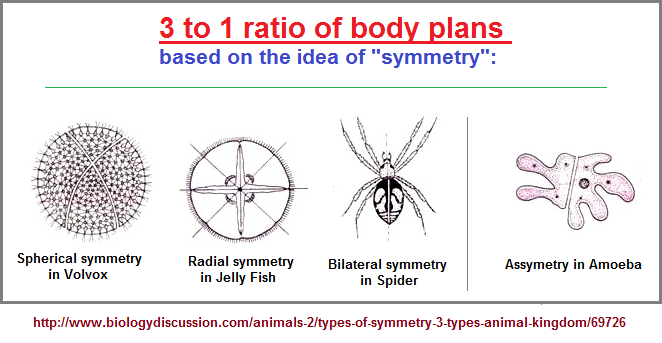
I generated different formulas of definition for the analog and digital terms in order to bring to the fore the idea which argues against the notion that we live in a digital world or that biology is based on an analogical orientation, because biology reeks of using discrete units of repetition that go unrecognized because no one is taking the time to catalog the recurrence and absence of identifiable patterns, which suggests the presence of a finite set of patterns and an overall limitation of expression, while living in an environmental system headed along a course of incremental deterioration for which we adopt a means of accommodating to by developing beliefs which act as rationalizations to support an unrecognized participation in efforts amounting to an assistance in our own eventual extinction?.
Take a look at the description of the world from the following article which gives the impression of being persuasive, only because the repeating patterns in various subjects are not readily recognized, much less being discussed. All of which, when we take the time to realize that the author's stated infiniteness of colors, tones, etc., are not infinite due to our physiology (even with electronic supplementation), leads us to ask what sort of biological do we actually have, if it is not purely analog nor digital? Do we thus turn to the usual course of dichotomization which is to claim a hybrid of the two, or come to realize we have reached a plateau in which an actual third type of definition is required... a definition that awaits a new order of thinking beyond the tricks employed by a brain that races to accommodate all world-views into some amalgamated dichotomy that is labeled otherwise, to give us the illusion of something more than two has been achieved? While the definition of what is meant by the world "analog" is reduced to the notion of "infinite possibilities" in the following article, the recurrence of a set quantity and quality of patterns occurring in nature suggests the existence of an imposed limitation, and therefore an inclination towards a non-analog world that is being described as being non-digital.
Analogous to this discussion, let us recall that the label sometimes used to describe the two-(patterned)- slit experiment which identifies an atom as assumed characteristics of being both a particle and a wave, is "wavicle". Instead of describing a totally different third type of entity, a mentality with a preference for seeing the world in a dichotomous fashion adopts a "blending" attitude. The same thing can now be said for what appears to be both an analog and digital identification amongst biological activity. However, if we do not amalgamate some notion of blending the two words Analog/Digital into a singularity, would we then consider the adoption of a third idea coupled to the idea that such a two-based expression of activity may well suggest a transitional phase of biological development into a third model, like the development of Germ layers which has followed a one-two-three course, even if the one and precursive stages of development into a single Germ layer are too far back in time to fully recognize?
Note: I have truncated and altered the article to reduce its size and oriented the content for the sake of abbreviation in-line with the current discussion.
Overview
We live in an analog world. There are an infinite amount of colors to paint an object (even if the difference is indiscernible to our eye), there are an infinite number of tones we can hear, and there are an infinite number of smells we can smell. The common theme among all of these analog signals is their infinite possibilities.
H.O.B. note: Clearly these statements are wrong. For example, anyone having taken a hearing test knows that they are endowed with a limited range of hearing certain tones. Likewise for those who are color blind, not to mention the philosophical discussions involved with trying to describe what we mean when we say "Red" or "Blue" or "White" or "Green" or "Black" or "Yellow" or "Orange" or any of the additive and subtractive variations of color. In other words, our definitions of color, of number, of beauty, of truth, etc., are taught to us in order that we might share a similarity of perception, even if we don't actually.
Digital signals and objects deal in the realm of the discrete or finite, meaning there is a limited set of values they can be. That could mean just two total possible values (such as) "255", "4,294,967,296", or anything as long as it's not ∞ (infinity).
"Signals" refer to time varying quantities of information that one may alternatively describe as "expressions" (or impressions) that may or may not be identifiable by the available receiver being used, nor exactly understood and (initially) conveyed (or re-conveyed) in a way so that a species (such as a human) might be able to perceive with their limited means of reception "channels" such as sight, hearing, touch, taste, etc. (Chemical and atomic receptions and expressions notwithstanding in this discussion.)
In other words, the type of radio or television receiver may not be able to "pick up" a given type of signal being transmitted over a particular (electromagnetic) range, and the person listening a given radio "set" (set of radio tubes/components) or watching a given television "set" (set of television tubes or components) may not be able to hear nor see nor understand what information is being transmitted and/or re-integrated by the radio or television set.
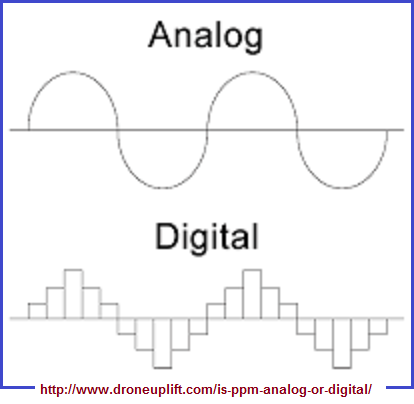
The details of a digital signal could be overlooked if one is more interested in a generalized over-view:
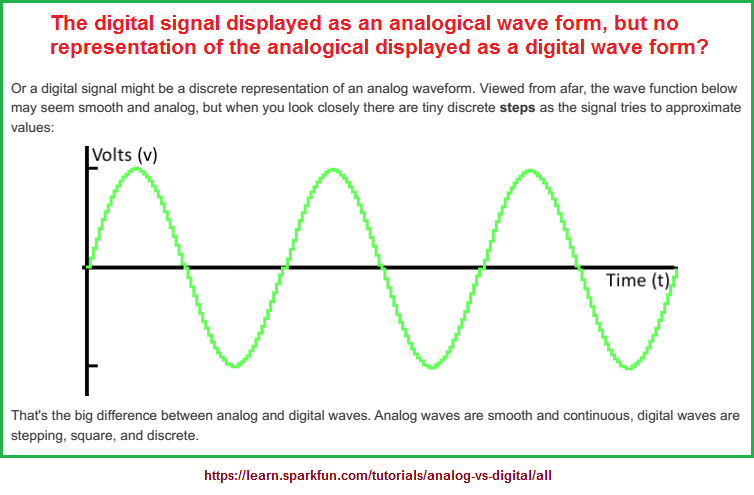
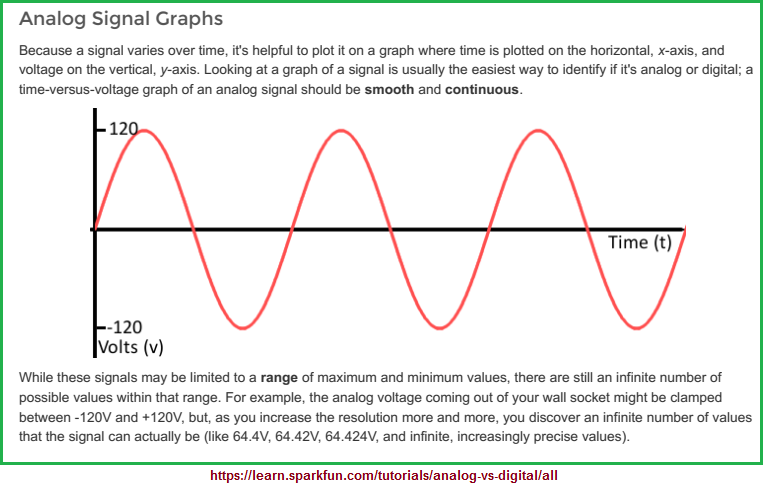
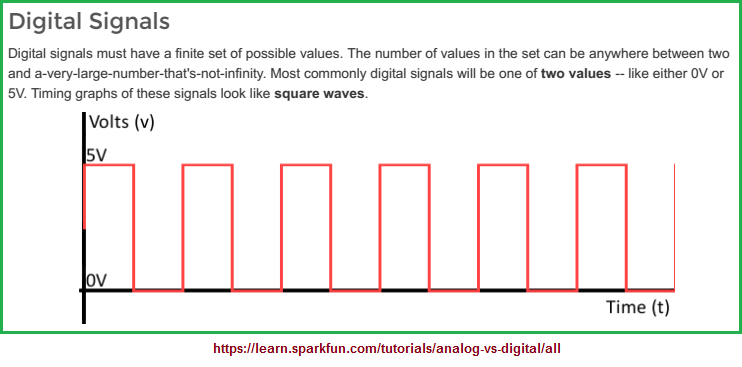
"Signals" outside the context of electronics can take different forms such as those typically perceived by any of the human senses, (smoke signals, temperature signals, "nuanced" signals, goose bump signals, "subtle energy" signals, "something there" signals, "feeling" signals, "minds eye" signals, heightened perception signals, lowered or dulled perception signals, drugged perception signals, double standard government signals, weather signals, animal movement signals, earthquake/geological signals, etc...), whether or not they are augmented by some machine, mechanism, or other-than-human based object or item.
With respect to displaying the differences between an analog and a digital signal, let us make note of not only the differences between an analog and digital oscilloscope, but also that 1 3-to-1 ratio can be interpreted from the different types of wave forms:
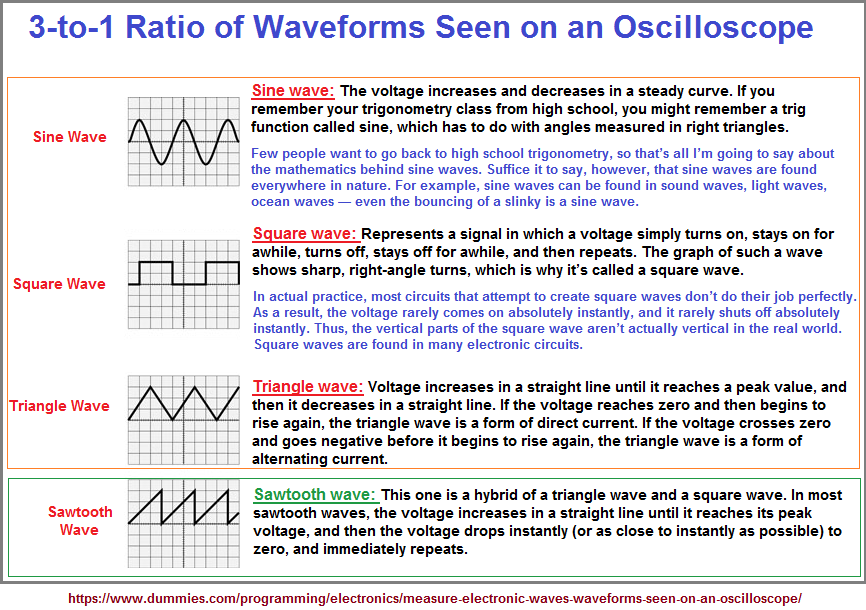
What are the differences between analog and digital oscilloscopes?
Analog oscilloscopes use high gain amplifiers to present the waveform on a CRT (cathode ray tube) screen. The entire signal processing taking place in an analog oscilloscope is in analog form. In a digital oscilloscope (DSO), an extra step is used before the signal is shown on the screen. That is the conversion of the signal into a digital stream by an analog to digital converter. Therefore, CRT type screens are no longer necessary, greatly reducing the complexity of the design. In theory, an analog oscilloscope can offer higher bandwidth. However, along with the progress in analog to digital conversion technology and digital signal processing, digital oscilloscopes have been rapidly improving, now offering impressive bandwidths. In addition, digital processing allows offering features that are not easily possible with analog technology. For example, signal manipulation and complex mathematics operations are standard features of a DSO from most manufactures. What are the differences between analog and digital oscilloscopes?
On the question of whether life is digital or analog posed to Freemon Dysan:
The two ways of processing information are analog and digital. An LP record gives us music in analog form, a CD gives us music in digital form. A slide-rule does multiplication and division in analog form, an electronic calculator or computer does them in digital form. We define analog-life as life that processes information in analog form, digital-life as life that processes information in digital form. To visualize digital-life, think of a transhuman inhabiting a computer. To visualize analog-life, think of a Black Cloud. The next question that arises is, are we humans analog or digital? We don't yet know the answer to this question. The information in a human is mostly to be found in two places, in our genes and in our brains. The information in our genes is certainly digital, coded in the four-level alphabet of DNA. The information in our brains is still a great mystery. Nobody yet knows how the human memory works. It seems likely that memories are recorded in variations of the strengths of synapses connecting the billions of neurons in the brain with one another, but we do not know how the strengths of synapses are varied. It could well turn out that the processing of information in our brains is partly digital and partly analog. If we are partly analog, the down-loading of a human consciousness into a digital computer may involve a certain loss of our finer feelings and qualities. That would not be surprising. I certainly have no desire to try the experiment myself.
Is life analog or digital?
Here is another discussion on which he speaks about the genome being digital and the brain remains a mystery, though some might suggest it as being at least partially analog:
Professor Dyson leaves the question as to whether life is analog or digital as a question to yet be answered. But, does the application of numbers to exhibited patterns of behavior assist us in making the determination? If so, then the dichotomy of using a two-bit assortment of zeros and ones to define an example of digital activity can be surmised with the usage of dichotomies found in different subjects. However, the highs and lows of an analog graph gives us the same impression of an active dichotomy taking place as well. And even though we routinely place a central line so as to give the means by which we can distinguish an upper and a lower, it is difficult to determine whether this act is a pattern-of-two or a pattern-of-three orientation. In other words, do we place a central line to emphasize a pattern-of-two (upper/lower), or provide us with the perspective of a third (central) point, whether or not we consciously acknowledge participating in this effort, which thus indicates we do not really know ourselves and any possible transitional stage of cognitive development which may or may not be taking place?
When we think about making a comparison with analog and digital processing and that of our brains, the following abbreviation of a longer article may be of service to those readers who are interested. However, let me note that the authors fail to provide a simple image of comparing an analog and digital wave as well as a hybrid (amalgamation). In fact, it my attempted research to find one on the internet via a google image search, there is a stark absence of such an illustration as of this date (10/30/2019), at 12:44 AM, though I had configured the following image several days ago while working on this 3-page (33a,b,c) section of the Devil's Advocate series. Several people speak of a hybrid model, but don't attempt to provide a visual illustration thereof:
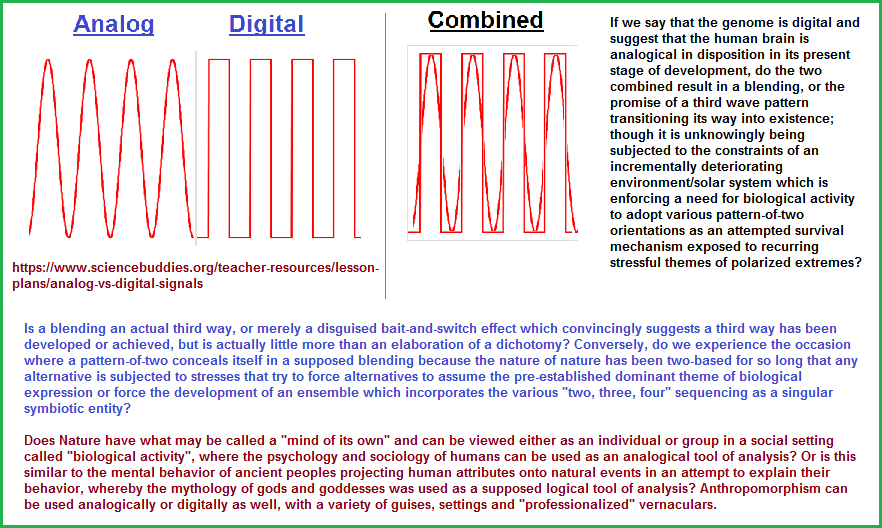
Analog Versus Digital: Extrapolating from Electronics to Neurobiology
Rahul Sarpeshkar
Department of Biological Computation,
Bell Laboratories, Murray Hill, NJ 07974, U.S.A.
We review the pros and cons of analog and digital computation. We propose that computation that is most efficient in its use of resources is neither analog computation nor digital computation but, rather, a mixture of the two forms. For maximum efficiency, the information and information processing resources of the hybrid form must be distributed over many wires, with an optimal signal-to-noise ratio per wire. Our results suggest that it is likely that the brain computes in a hybrid fashion and that an underappreciated and important reason for the efficiency of the human brain, which consumes only 12 W, is the hybrid and distributed nature of its architecture.
Introduction
We estimate that the human brain performs on the order of 3.6×1015 synaptic operations per second (appendix A.1 in Sarpeshkar, 1997). From measurements of cerebral blood flow and oxygen consumption, it is known that the brain consumes only 12 W (appendix A.2 in Sarpeshkar, 1997). Its efficiency of computation is thus about 3×1014 operations per joule. The human brain is capable of doing tremendously complex computation in real time despite the slow and noisy components in our heads and bodies. An extremely fast microprocessor such as the DEC Alpha 21164 performs about 255 × 106 floating-point operations per second and consumes 40 W.1
1On the specfp92 Ear Program, which performs auditory computations similar to those in the human ear, the DEC 21164 running on an Alpha Server 8200 5/300 is 1275 times as fast as a VAX 11/780, which would run at about 0.2 MFLOPS for our computation. Thus, we estimate that it is equivalent to about 1275×0.2 = 255 MFLOPS. These numbers are for 1995.
Its efficiency is thus about 6.25 × 106 operations per joule. It is incapable of solving even relatively simple behavioral tasks in real time in spite of its blazingly fast and precise transistors. If we compare the computing efficiency of the human brain with that of a digital microprocessor, we observe that the brain is at least seven orders of magnitude more efficient.2
2It may be argued that our comparisons have not been fair since the floating-point computations that a microprocessor performs are more complex than are those that a synapse performs, and they are also more precise. However, in addition to multiplication, synaptic computations involve temporal filtering and adaptation, which are fairly complex operations in digital computation. We have also neglected several complex spatiotemporal correlations and additions that are performed in the dendrite of a neuron. Thus, for simplicity, we have chosen to compare just the efficiency of an "elementary operation" in digital computation and in neurobiology. There are so many orders of magnitude of discrepancy between neurobiology and electronics that such concerns will not alter our conclusions.
Mead was the first scientist to point out the great discrepancy in the computational efficiencies of neurobiology and electronics (Mead, 1990). He also pioneered the field of neuromorphic computation—electronic computation inspired by and similar to that performed by neural systems (Mead, 1989).
How is efficient and complex computation with noisy components achieved in neurobiological systems? Mead attributed the enormous efficiency of neurobiological systems to their clever exploitation of the physics of the medium that they were built in, to their local wiring strategies, and to their enormous capabilities to adapt and learn. In this article we will focus on the trade-offs involved in using physics to do computation.
The three physical resources that a machine uses to perform its computation are time, space, and energy. Computer scientists have traditionally treated energy as a free resource and have focused mostly on time (the number of clock cycles required for the computation to terminate) and space (the amount of memory needed or the number of devices needed to perform the computation). However, energy cannot be treated as a free resource when we are interested in systems of vast complexity, such as the brain. With the current efficiencies of digital computation, it would take tens of megawatts to build a system like the brain, assuming we could do so at all. If we wanted to make this system portable as well, energy constraints would be very important indeed. Energy has clearly been an extremely important resource in natural evolution. (For an interesting discussion on energy constraints in biology and evolution, see Allman, 1990; and Aiello & Wheeler, 1995.) On a smaller scale, energy constraints are important in all portable applications, such as radio telephony, laptop computing, and hearing aids.
Biological systems typically compute constantly, rather than episodically, with the resource of time fixed by the computational requirements of the task. For example, for a sensorimotor task, we may need to respond within a few hundred milliseconds, whereas for the task of hearing a 1 K Hz tone, we will need to respond to cycle-by-cycle variations on a 1 msec time scale. Thus, throughout this article, we will assume that the bandwidth of the computational task is fixed and that the resource of time is not a degree of freedom (it will be a parameter in our equations but not a variable). The other two resources (energy and space) will be degrees of freedom; we shall use the more natural resources of power (energy per unit time) and area (the spatial resource in a two-dimensional substrate such as nerve membrane or in VLSI) as our degrees of freedom.
Suppose that we are given two systems, A and B, that do a computation at the same bandwidth (in Hz), at the same output information rate (in bits/sec), and with the same input. A is more efficient than B if it consumes less power (and/or area) in doing this computation. In this article, we shall be interested in understanding the reasons for the efficiency of one system over another. In particular, we will study the reasons for differences in efficiency between analog and digital systems.
Electronic systems are far simpler to understand and analyze than are biological systems. So in sections 2 and 3, we begin by analyzing the differences between analog and digital electronic systems. In section 4, we use the insights gained by this analysis to outline how efficient, precise computation can be achieved by hybrid and distributed electronic architectures. In section 5 we extrapolate our ideas for electronic systems to neurobiological systems. Section 6 summarizes the article.
Analog Versus Digital: The Intuitive Picture
Electronic systems operate with continuous signals (CS) or discrete signals (DS), and in continuous time (CT) or discrete time (DT). Thus, there are four classes of systems: CSCT, CSDT, DSCT, DSDT (Hosticka, 1985). Figure 1 shows examples of systems, either electronic or biological, in each class.
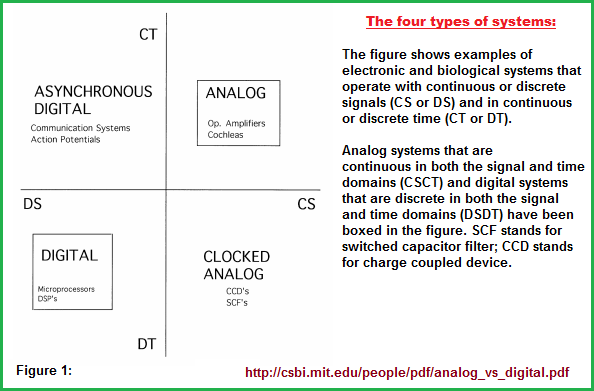
Typically, CS systems are referred to as analog, and DS systems are referred to as digital, irrespective of their representation in the time domain. In this article, we first concentrate on analog systems that are continuous in both the signal and time domains (CSCT), and on digital systems that are discrete in both the signal and time domains (DSDT). Such systems are the most common examples of analog and digital systems, respectively, and are also the most disparate from each other. Later, in section 4, we discuss why an alternation between the CSCT and DSCT domains can be advantageous over operation in the DSDT or CSCT domain alone. We shall ignore the CSDT domain in this article because its relevance to neurobiology is generally believed to be small...
Analog Digital Compute with continuous values of physical variables in some range, typically voltages between the lower and upper power-supply voltages. Compute with discrete values of physical variables, typically the lower and upper power supply voltages, denoted by 0 and 1, respectively. Primitives of computation arise from the physics of the computing devices: physical relations of transistors, capacitors, resistors, floating-gate devices, Kirchoff’s current and voltage laws and so forth. The use of these primitives is an art form and does not lend itself easily to automation. The amount of computation squeezed out of a single transistor is high Primitives of computation arise from the mathematics of boolean logic: logical relations like AND, OR, NOT, NAND, and XOR. The use of these primitives is a science and lends itself easily to automation. The transistor is used as a switch, and the amount of computation squeezed out of a single transistor is low. One wire represents many bits of information at a given time. One wire represents 1 bit of information at a given time Computation is offset prone since it is sensitive to mismatches in the parameters of the physical devices. The degradation in performance is graceful. Computation is not offset prone since it is insensitive to mismatches in the parameters of the physical devices. However, a single bit error can result in catastrophic failure. Noise is due to thermal fluctuations in physical devices. Noise is due to round-off error. Signal is not restored at each stage of the computation. Signal is restored to 1 or 0 at each stage of the computation. In a cascade of analog stages, noise starts to accumulate. Thus, complex systems with many stages are difficult to build. Round-off error does not accumulate significantly for many computations. Thus, complex systems with many stages are easy to build.
Analog Versus Digital: Extrapolating from Electronics to Neurobiology by Rahul Sarpeshkar
Origination date: Thursday, October 24th, 2019... 2:57 AM
Initial Posting: Wednesday, October 20th, 2019... 5:33 AM
Updated Posting: Friday, January 20th, 2023... 12:30 PM
Herb O. Buckland
herbobuckland@hotmail.com